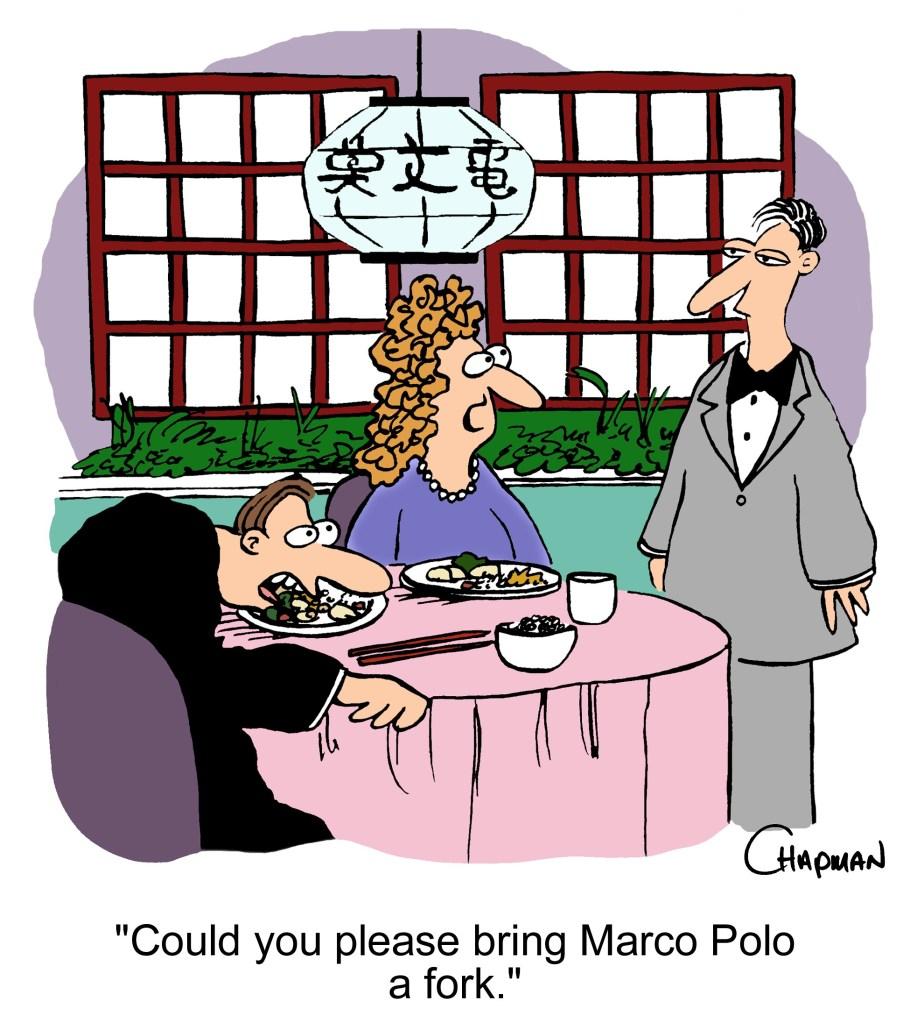
Since moving to Asia I’ve had many a ‘chopstick moment’ (and probably many times before if the truth be known.)
These ‘moments’ are when I fumble awkwardly with my two sticks, discreetly trying to determine whether they’re the right way up before gingerly attempting to clasp my rice and other slippery suckers that lurk menacingly in my bowl in the most civilised way possible (when no one’s looking I’ve been known to stab my chopstick into the food for better leverage.)
Naturally my inability has only been highlighted living in a country where the chopstick is a national icon. Invented in China, they’re said to reflect the wisdom of ancient Chinese people.
You can appreciate, eating at local restaurants (often one of the only Gwailos) is more than enough to feed my chopstick anxiety.
Not that I’ve got a complex or anything, but it’s hard to miss the amused looks as waiters circle our table like sharks, stifling their smirks and jabbering away in cantonese (clearly entertained by the white girl’s clumsy attempts to get so much as a grain of rice into her mouth.)
In the beginning I would accept defeat immediately – ditching the sticks and humbly requesting a knife and fork.
These days I’m more accepting of the challenge and proud to say, I’m gaining ground on the proverbial stick!
I’ve recently read it’s completely acceptable to ‘transfer’ food to closely related people if they’re having difficulty picking up the food, so I’m wondering why my more skilled (in the chopstick arena) husband hasn’t offered to do this as a polite, caring gesture.
A girl’s gotta eat!
So about now you might be thinking my paranoia about the chopstick police is a little overrated….but trust me, this is a place with the longest continuing civilization ever! Yes ever!
The culture of chinese cuisine is 5000 years old and you don’t want to mess with it.
There are rules even the humble chopstick is not immune to.
Number one: make sure you always hold the chopsticks in the middle, don’t suck on them, use them to move dishes or pierce food. (I knew that!)
No banging them like drums – this suggests you are a beggar.
Whatever you do – don’t stick the chopsticks vertically into your bowl of rice. This implies the food is for the dead. (When somebody dies, the shrine to them contains a bowl of sand or rice with two sticks of incense stuck upright in it.)
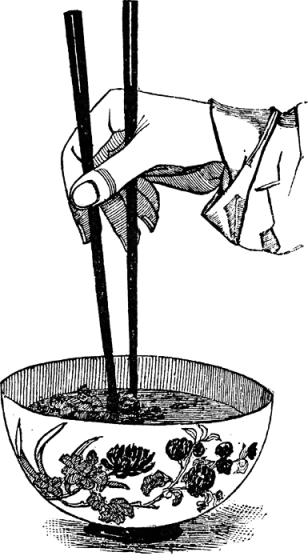
Right. Noted!….are you feeling my angst?
So I’m on the way to mastering chopsticks…but it turns out good chopstick etiquette alone isn’t going to cut it.
Like I said, the chinese cuisine culture is detailed, complex and rooted deeply in history.
I’m coming to realise ‘food’ in these parts is not just about serving up a burger and chips with a splurge of tomato sauce.
It’s an art.
There is a strict criteria for a fitting feast that must be met.
Colour, aroma, taste and presentation are crucial but more importantly, the meal must adhere to the philosophy of ‘Yin and Yang.’
In food, Yin represents feminine, damp, mild and cool elements like water, bean sprouts, cucumber, crab.
Yang is bright, masculine, dry, strong and hot like ginger, garlic, onion, chill pepper, red meats.
It’s essential to get the balance just right.
Once you’ve got this down pat, the meal should resemble something of an artist’s creation.
The ‘painting’ if you like, is made up of gold soups, white rice, the bright greens of vegetables, reds of condiments and the orange of meats and sauces.
You get the picture!
These should also ‘match’ the surroundings and environment.

(Yes if my chopstick inadequacy isn’t enough… you can betcha I’ve got reservations about hosting a dinner party.)
An invitation to guest star at a dinner party is not without its challenges either. As in many countries, it’s customary to give the host a gift…not much to ask, but here’s where it gets tricky.
Don’t give anything that’s green. It’s a sign of weakness. Avoid white like the plague – It means death and funerals.
It’s unlikely you’d give someone a clock to say thank you for dinner but just in case, it too symbolizes death or the end of a relationship.
Giving a book is like delivering defeat and an umbrella (again probably not your gift of choice, but just so you know) implies that the receiver will be dispersed with.
Very importantly, don’t give gifts in quantities of four as the word “four” sounds similar to the word for “death.” (Also explains why there are no 4th floors in any Hong Kong buildings…)
Looking on the bright side..red, however, is lucky, yellow signifies happiness and gold represents fortune or wealth, so if you wrap your perfectly appropriate present in these colors you’re sure to be invited back.
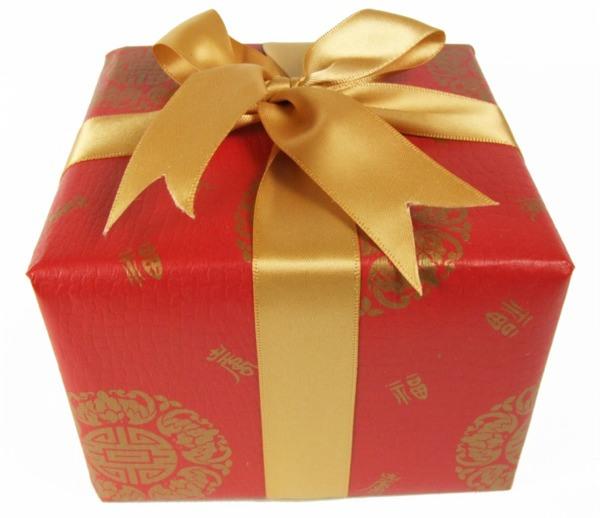
Oh and when you do give the gift, make sure you give it with BOTH hands.
Right so you’ve made it into the house (shoes off) without too much embarrassment….lets talk about the food because you will be expected to try a few suspicious looking dishes.
Cantonese are renowned for having adventurous palates, in fact, people in Northern China have been known to say, “Cantonese will eat anything that flies except planes, anything that moves on the ground except trains and anything that moves in the water except boats.”
I’m not sure they’d agree but traditionally dogs, snake and jungle delicacies were all part of their cuisine.
Thankfully that’s not the case today, but there are still a few, shall we say, dubious bites that rank up there with the best of the best in chinese culinary delights.
It’s all about the food’s medicinal properties.
Again, I’m talking the Yin and Yang.
An imbalance of natural “heat” and “cold” in the body can cause disease or make you more conducive towards sickness.
So what’s likely to be on the food therapy menu?
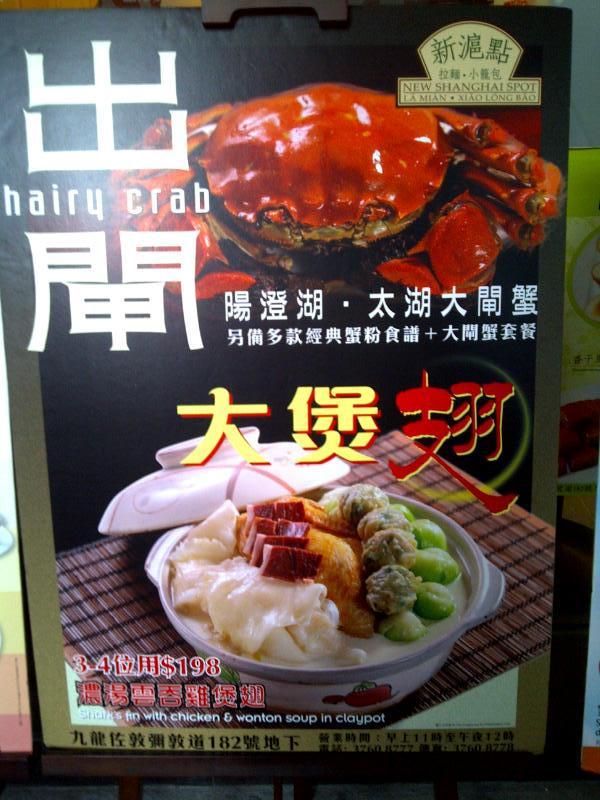
At the moment, it’s hard to walk past any local restaurant in Hong Kong and not see a sign out the front proudly displaying ’hairy crab.’ If it’s not on the table, you may as well commit cuisine suicide!
They call it the ‘Hairy Crab phenomenon’ and whenever I’ve curiously asked the locals about this famous crabby critter, the sheer enthusiasm and delight with which I’m regaled Hairy’s heroics is hard to miss.
Hairy plus food – probably doesn’t sound like much of an appetizing combination, (unless you’re into Italian men of course) but rest assured, in Asia, this shaggy crustacean is more than just your average trussed-up lobster.
In Chinese, Hairy Crab sounds like the word ‘harmony,’ which pretty much sums up the mood this highly regarded crustacean evokes in his consumers.
The pomp and ceremony is short and sweet. Autumn is when the curtains open and Hairy Crab is on parade for a few short months.
With such limited crab cracking time, locals go to great lengths, not to mention shell out huge expense for the sought after species. You’re looking at $50US a crab.
The female crab roe is what really gets the audience cheering. Sweeter in taste (naturally) it’s cooling (yin) effect on the body means it’s served with “warming” condiments.
Hairy is so popular in China, ‘vending machines’ have been introduced in train stations!
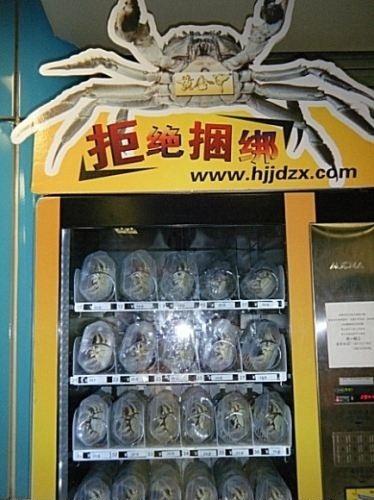
Yep! these fuzzy shellfish are stored at five degrees celsius to induce a sleepy state of hibernation, ensuring they are fresh and alive when you push your coins in the slot (and you thought buying chocolate in the vending machine was the highlight of many a working day!)
We all know China is legendary for fakes. ‘Copy’ rolex watches and designer handbags are all part of the great chinese tapestry of life (the shopaholic in me is thrilled to say) but what about counterfeit crabs?
At $105 US a kilo, fake hairy crabs raised in less hygienic locations are being sold with counterfeit trademarks to millions of unsuspecting buyers.
Peddled on street corners and in bustling markets, Shanghai airport even puts up signs to forbid the transportation of live crabs as ‘hand luggage.’ (I guess it’s gotta be easier than traveling with a toddler right?!)
While we’re on the topic of highly sought-after goods, ladies, if Bird’s Nest soup is on the menu, it could well be worth tucking into a bowl of this anti-aging beauty broth.
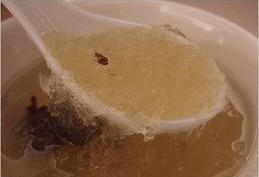
Made from bird’s saliva, when dissolved in water the nests have a gelatinous texture and have been used in soup for over 400 years.
Bird’s nest is among the most expensive animal products consumed today. Who needs pricey beauty products when you’ve got bird’s saliva?
Not only does it give you glowing skin, it can aid libido and digestion, alleviate asthma, improve focus and has an overall benefit to the immune system.
You’re looking at $30 to $100US for the Elixir of Life in a bowl!
Shark’s Fin soup is another one lauded for its alleged medicinal properties. Originating centuries ago during the Ming Dynasty, it’s said to boost sexual potency, enhance skin quality, increase one’s qi or energy, prevent heart disease, and lower cholesterol.
Symbolizing wealth, power, prestige and honor, the chinese consider it to be one of the eight treasured foods from the sea.
(Folklore has it that “a bride marrying into a family without shark fin soup on the table is marrying into a poor family.”)
Even today, any function worth its weight in gold must have Shark’s Fin soup on the menu or guests are left distinctly unimpressed and the hosts lose face. (Not something you want to do in China where it’s all about ‘saving’ face….but that’s a story for another day.)
Demand for Shark’s Fin has slowed in Hong Kong more recently with renewed concerns over the way sharks are finned. Locals are starting to shun the expensive delicacy for more sustainable seafood and several major hotels have stopped serving it altogether.
Ranking itself up there as a dinner party delight with Shark Fin, Hairy Crab and Bird’s Nest is Abalone…this seafood is also in limited supply and you guessed it, expensive.
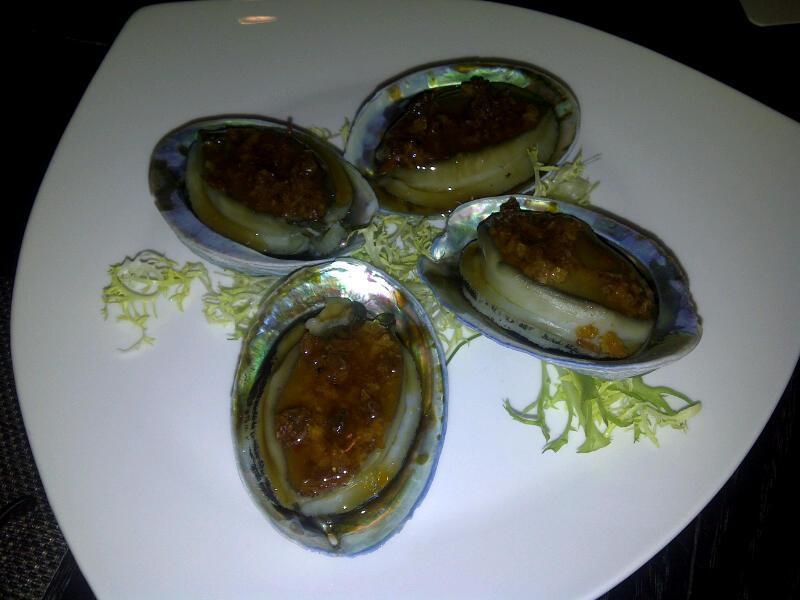
Called ‘Bao Yu’ in Chinese, there was a time when you needed blue blood to get a look in at this chewy delicacy.
Most Abalone are ironically found in Australia – the world’s largest supplier but surprisingly not so revered down under!
At the risk of showing my age, a child of the seventies, I remember when the Abalone ‘mother of pearl’ shells were used in many retro households as stylish ash-trays.
These days, you’re without doubt a lot better off consuming the rubbery textured snails than you are ‘lighting up’ and ‘butting out’ in their shiny shells.
Not just a status symbol but an adjunct therapy for cancer and a brightener and healer for the eyes, Abalone also increases appetite and is a health food for the liver and kidneys.
Our table was given a plate of Abalone last night compliments of the chef….a tad on the tough and tasteless side, it was edible in a ‘calamari kind of way.’
My husband, not so keen, discreetly discarded his immunity boost.
Little did he know it’s an aphrodisiac like its fellow mollusk, the oyster – explaining why it’s long been a favorite of China’s long-lost mandarins and aristocrats.
(Meantime, I smuggled the Abalone shell into my purse – smokin’ seventies or not, it’s a nice looking ornament!)
Now, this is not a delicacy nor medicinal but I can’t finish this article without mentioning the ubiquitous chicken feet.
It’s a safe bet you’ll see this on the table.
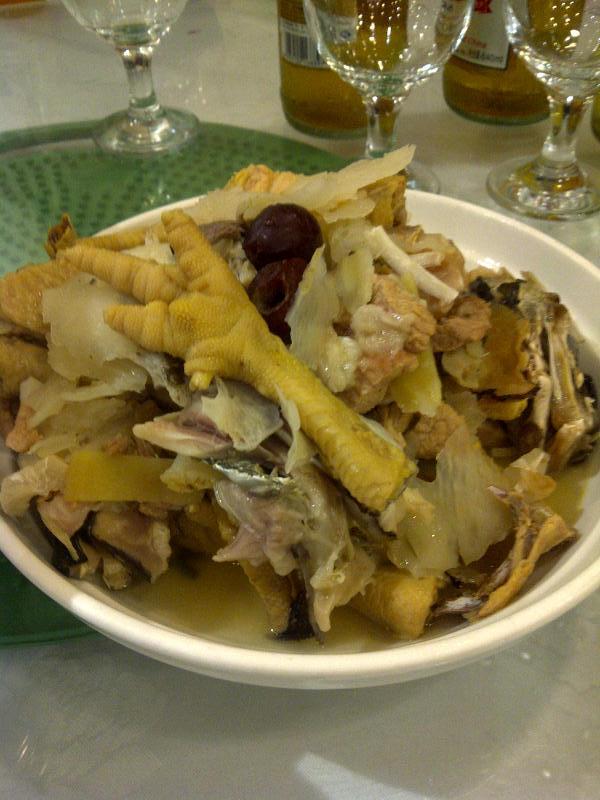
Today, packaged chicken feet are sold in most supermarkets in China as a snack. Chew the soft bones and skins of chicken feet and spit out the harder bones. A bit like a chewing gum habit I’m told?!
So….while you might feel like you’ve checked into a health retreat with all that immunity boosting tucker, the hardcore slurping going on around the table is a noisy reminder, you haven’t!
Contrary to western ways, making noise is not considered impolite but rather a compliment that you are enjoying the food. A very loud slurp can mean you’ve finished eating.
(It’s about here I take no responsibility for my daughter’s future table manners.)
So bellies full or not (depending how your taste buds are fairing) you’ll also be offered a lot of tea…a bit like the Brits, China is a nation of tea lovers, but the Chinese tea trend goes way back to 2737 B.C.
As well as its healing powers, it’s also a sign of respect to pour a cuppa for an older person, tea acts as an apology and even expresses thanks.
At a dinner not so long ago I began to wonder about the musical table-tapping taking place.
Turns out after one’s cup is filled, it’s customary to knock your bent index and middle fingers on the table to give gratitude to the person who served the tea. Ah huh!
So, dinner is done, you’ve survived without losing face – it’s time to get your singing mojo on because Chinese love to sing and they especially love Karaoke! It’s quite normal as I’ve discovered (much to my horror) to sit in a circle after dinner and watch each other sing! In fact Chinese are generally more shy about dancing in public than singing.
I’ll take a bit of an uncoordinated public boogie over some shameful warbling any day thanks!
Right, hope you got all that!
I think you’re ready for your dinner date with destiny!
Cheers! or as they say in China, Yum Boy!


